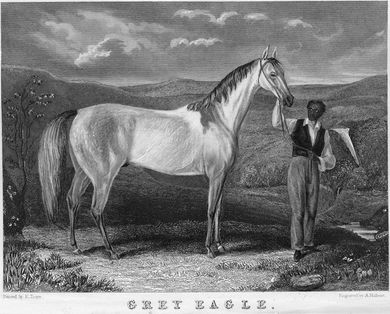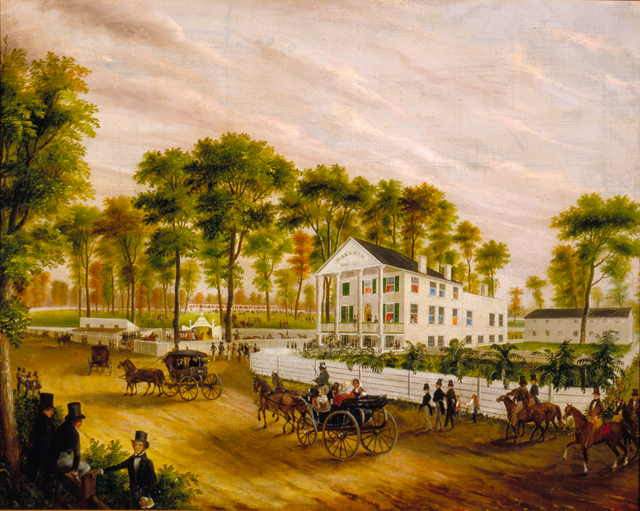Annotation:Grey Eagle (1)
X:1 T:Grey Eagle [1] M:C| L:1/8 R:Reel B:Coes Album of Jigs and Reels, something new, for professional and amateur violinists, B:leaders of orchestras, quadrille bands, and clog, reel and jig dancers; consisting of a B:Grand Collection of entirely New and Original Clog-Hornpipes, Reels, jigs, B:Scotch Reels, Irish Reels and Jigs, Waltzes, Walk-Arounds, etc. (1876, p. 58) N:Coes performed with the San Francisco Minstrels in California from 1852 to 1859. Z:AK/Fiddler's Companion K:A c/B/|:ABAF EFEC|EEdc BdcB|AFF/F/F/F/ EFEC|EAGB AdcB| AFF/F/F/F/ EFEC|E2 dc Bc d2|ecBc AFEC|1A,AcB A2 zc/B/:|2 A,AcB A2 zc/d/|| |:eA.A/.A/.A/.A/ (ec)(fc)|eA.A/.A/.A/.A/ (fe)(af)|eA.A/.A/.A/.A/ (ec)(fc)|dcBA GB(3.E.E.E| eA.A/.A/.A/.A/ (ec)(fc)|ecde {g}fefg|(3.a.a.a (3.a.a.a agfe|1dcBA Bcd^d:|2 dcBA BdcB||
GREY EAGLE [1]. AKA and see "Gray Eagle." AKA – "Grey Eagle Hornpipe." Old-Time, Bluegrass, Texas Style; Breakdown, Hornpipe. USA; Alabama, Mississippi, southwestern Va., southwestern Pa., western N.C., eastern Tenn., Kentucky, Missouri, Indiana, Oklahoma, Texas, Arizona. A Major (most versions): G Major (Bayard, W.E. Claunch): C Major (uncommon, but known in the western N.C./ eastern Tenn. area in this key). Standard or AEae tuning (fiddle). AB (Bayard, Silberberg): AABB (Brody, Krassen, Phillips): AABB' (Coes): AA'BB (Shumway): AABBCC (Christeson): AA'BB'CC'D (Frets Magazine). "One of the standard square dance tunes in the key of A Major" (Krassen, 1973), and, in fact it is one of the more commonly played fiddle tunes at mid-western fiddle contests. Versions and variants abound in tradition, so that the title is sometimes qualified with the name of the source to differentiate it from other "Grey Eagle's." Several writers have noted the similarity between "Grey Eagle" and the Scottish tune "Miller of Drone (1) (The)," with the "Grey Eagle" melody probably derivative. There are many different sets of this tune collected from folk sources in almost all parts of the South and West; in addition it has made its way into numerous commercial collections, among the first of which is George H. Coes' Album of Music (Boston, 1876). It was one of the older tunes in fiddle repertory in Patrick County, southwest Va., before such tunes were supplanted by tunes more conducive to the fiddle/clawhammer banjo combination—the tune may also have been called "Ducks on the Pond" (??) (Tom Carter & Blanton Owen, 1976). Bayard (1981) is surprised at the tenacity of the title in the face of so many disperate versions.

The melody is popular with Kentucky fiddlers, remarks Charles Wolfe (1982), who suggested it was named for the famous Kentucky race horse of 1839. The connection had been made in print long before Wolfe, however, as evidenced by this excerpt from The Dallas (Tx) Morning News of April 8, 1900, which reported on an old fiddlers' contest held the previous day:
John Hartford ("The Devil's Box") found that the "Grey Eagle" title for the melody known as "Miller of Drone (1) (The)" became attached to the tune in America following this famous late 1830's race between horses known as "Grey Eagle" and "Wagner." The race has been documented and took place in the Oakland Racetrack in Louisville in 1838. Soon afterwards a tune folio celebrating both racehorses appeared (a copy of which is in the possession of the Center for Popular Music at Middle Tennessee State University, Murfreesboro) with both "Wagner" and "Grey Eagle" as well as the now-obscure "Oakland Racetrack." In fact, the ancestral melody "Miller of Drone (1) (The)" melody gave rise to a tune called "Gray Eagle Cotillons" by William C. Peters, published in 1840, named for the horse in the race in Louisville.Mr. Matthews of Sherman played ‘Waggoner.’ This is a Tennessee tune, a companion piece to the Kentucky tune 'Gray Eagle.' Fifty years ago they were the favorite airs of the country west of the Alleghanies. They were named for two horses, Waggoner and Gray Eagle. The former was a Tennessee horse and the latter a Kentucky horse. They were pitted against each other, and the States bet all they had on the result. That day Kentucky dropped more tears and money than it had ever done before or has done since. Many a Kentuckian who is now working for newspapers and engaging in other menial employment would have been rich today if their grandfathers had not attended that race and had confidence in Gray Eagle. [1]

"Grey Eagle" was in the repertoire (C Major version) of legendary fiddler J. Dedrick Harris, a Tenn. born fiddler who played regularly with Bob Taylor when the latter ran for Governor of the state in the late 1800's. Harris moved to western N.C. in the 1920's and influenced a generation of fiddlers there, including Osey Helton, Manco Sneed, Bill Hensley, and Marcus Martin. In the Deep South the melody was in the repertory of Alabama fiddler D. Dix Hollis (1861–1927), who considered it one of "the good old tunes of long ago" (as quoted in the ''Opelika Daily News of April 17, 1926) {Cauthen, 1990}, and was recorded for the Library of Congress in 1939 by Guntown, Mississippi, fiddler W.E. Claunch. It was also one of the tunes listed in the Troy Herald of July 6th, 1926, as having been played at a fiddlers' convention held at the Pike County, Alabama, fairgrounds. It is on Missouri fiddler Charlie Walden's list of '100 essential Missouri fiddle tunes'. Mark Wilson reports that a surprising number of fiddlers in the Ozarks and Midwest were aware that "Grey Eagle" and "Wagoner (1)" were tune titles associated with racehorses. He suggests that, since he did not find eastern Kentucky fiddlers shared this knowledge, the tune gained currency in the Midwest, and from there entered tradition in regions to the east. Part of the tune the same as "Ostinelli's Reel" (Cole). Arizona fiddler (and Mormon) Kenner C. Kartchner maintained the tune was played by Mormon fiddlers crossing the plains. "First Month of Summer (The)" and "Sugar Grove Blues" may also be cognate melodies.
Early sound recordings of "Grey Eagle" are of the playing of J.Dedrick Harris (1924), Taylor's Kentucky Boys (1927, biography:Jim Booker [2]on fiddle), Roland Cauley & Lake Howard (1934), and by north Georgia fiddler Lowe Stokes (1929), albeit the latter's version was released under the title "Katy Did."
- ↑ quoted from response by 'Brian' 7.9.15 to "Gray Eagle" at Oldtimeparty.worpress.com [3]
- ↑ John Harrod, in a 2012 oral history interview with Scott Prouty, said of a north-central fiddler he tracked down, Pretzel Brolyes: "...He was good, too. He'd grown up down around Camp Nelson and played Jim Booker's "Grey Eagle" pretty close to the way Booker did. He knew the Bookers and that black fiddle scene down there but he had moved up to Glencoe.

